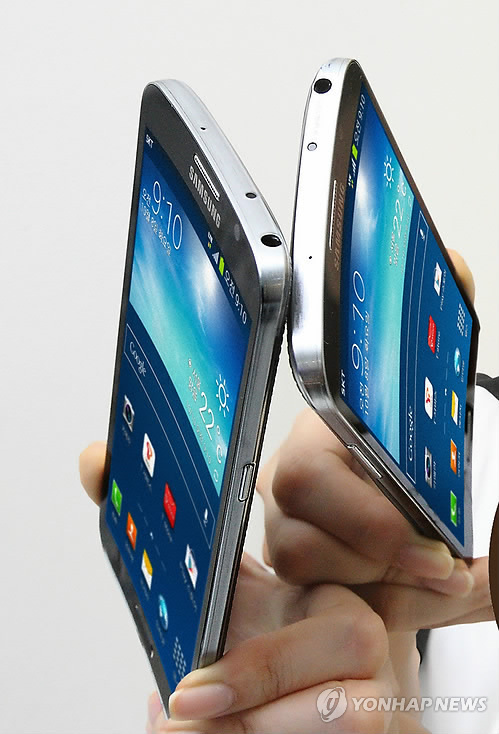 |
Samsung Electronics’ curved smartphone Galaxy Round, released in October. (Yonhap News) |
Samsung is highly unlikely to adopt Youm, a curved display panel, for the Galaxy S5 smartphone due to its insufficient capacity, industry sources said.
“The current capacity for flexible panels is not high enough for the Galaxy S5, which will be rolled out early next year. Curved ones will be unveiled late next year as a Galaxy variant rather than as a flagship model,” said Kim Jong-hyun, an analyst at Seoul-based Eugene Investment & Securities.
In line with this, the Suwon-based tech giant earlier delayed its investment in the A3 line for flexible organic light-emitting diode panels to early next year.
Currently, the company is capable of handling 8,000 5.5-generation sheets per month to produce up to 500,000 flexible panels for smartphones, with a 30 percent yield. With the A3 line investment, the capacity may rise to 1 million panels late next year, said a source close to Samsung who declined to be identified.
Samsung’s Galaxy Round, with a battery that is not curved and a display composed of both glass and plastic, will reportedly sell only 50,000 units domestically.
Apple is not expected to adopt curved displays for its iPhone 6 either, as the only capable flexible suppliers ― Samsung Display and LG Display ― cannot even meet their own needs. LG Display is capable of handling 12,000 4.5-generation sheets per month, reportedly producing fewer panels than Samsung.
“It is difficult for Apple to adopt curved display next year, though 2015 is more plausible,” said John Seo, an analyst at Shinhan Investment.
Another industry source said that since Japan Display is even further behind, LG Display may serve as the leading vendor with Samsung Display close behind. The possibility of adopting panels from Chinese companies is much lower, the source added.
“Apple is a very difficult client. Suppliers must disclose every cost and detail and reap little profit. Chinese companies may not stand it at least for now,” a source said.
Despite Samsung and LG’s growing anxiety over the fast game of catch-up that Chinese companies are playing in the LCD industry, OLED technology development appears to be slow in both the smartphone and television segments. The two Korean firms ambitiously and competitively unveiled their large OLED TVs early this year, which consumers have turned away on their high cost.
“Next year, both Samsung and LG will focus on ultra-high-definition TVs, as the yield issue for OLED TVs is not expected to be solved by then,” Kim of Eugene Investment said.
By Shin Ji-hye (
shinjh@heraldcorp.com)




![[Herald Interview] 'Trump will use tariffs as first line of defense for American manufacturing'](http://res.heraldm.com/phpwas/restmb_idxmake.php?idx=644&simg=/content/image/2024/11/26/20241126050017_0.jpg)

![[Health and care] Getting cancer young: Why cancer isn’t just an older person’s battle](http://res.heraldm.com/phpwas/restmb_idxmake.php?idx=644&simg=/content/image/2024/11/26/20241126050043_0.jpg)

